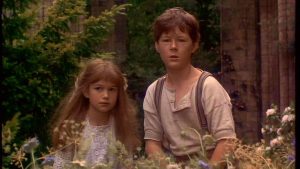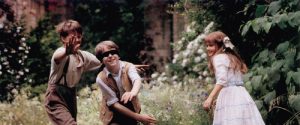The Secret Garden (1993)
- fanmovies
- October 10, 2024

The Secret Garden (1993) is a beautifully crafted adaptation of Frances Hodgson Burnett’s beloved novel. Directed by Agnieszka Holland, the film captures the enchanting and transformative power of nature and friendship. Here’s a detailed review:
Plot Summary
The story follows Mary Lennox (Kate Maberly), a lonely and spoiled girl who is orphaned after a cholera outbreak in India. Sent to live with her reclusive uncle, Archibald Craven (John Lynch), in a vast, gloomy mansion in England, Mary initially struggles to adapt to her new life. Isolated and ignored, she discovers a hidden garden on the estate, which has been locked away for years. As she begins to tend to the garden, she encounters her sickly cousin Colin (Heydon Prowse) and the kind-hearted gardener, Dickon (Andrew Knott). Through her friendship with Colin and Dickon, Mary embarks on a journey of healing and personal growth, revitalizing not only the garden but also the spirits of those around her.
Themes
- Healing and Renewal: The garden serves as a powerful symbol of healing and renewal. As Mary, Colin, and Dickon nurture the garden, they also heal their emotional wounds and grow stronger together.
- Friendship and Connection: The film emphasizes the importance of friendship and human connection. Mary’s relationships with Colin and Dickon transform her from a lonely, unhappy child into a caring and compassionate individual.
- Nature’s Power: The Secret Garden celebrates the restorative power of nature. The garden itself becomes a magical place where the characters can escape their troubles and find solace, reinforcing the idea that nature can bring joy and healing.

Character Development
- Mary Lennox: Kate Maberly’s performance as Mary is compelling. She evolves from a selfish and bitter girl into a caring and nurturing figure, reflecting the transformative power of love and friendship.
- Colin Craven: Heydon Prowse’s portrayal of Colin captures the character’s initial fragility and subsequent growth. His journey from a sickly, fearful boy to a vibrant, confident child mirrors Mary’s transformation.
- Dickon Sowerby: Andrew Knott’s Dickon is a charming and free-spirited character, representing the connection to nature. His kindness and enthusiasm play a crucial role in encouraging both Mary and Colin.
Direction and Cinematography
Agnieszka Holland’s direction beautifully balances the film’s darker themes with moments of whimsy and magic. The cinematography captures the stark contrasts between the cold, gloomy mansion and the vibrant, lush garden, enhancing the film’s emotional impact. The visuals are stunning, with rich colors that bring the garden to life and create a sense of wonder.
Pacing and Editing
The pacing of The Secret Garden allows for a gradual unfolding of the story and character development. The editing effectively intersperses moments of reflection with scenes of growth and joy, creating a well-rounded narrative. The film takes its time to explore the characters’ emotional journeys, allowing viewers to connect with their struggles and triumphs.
Conclusion
The Secret Garden (1993) is a heartfelt and visually enchanting adaptation that captures the essence of Frances Hodgson Burnett’s novel. With strong performances, particularly from Kate Maberly and Heydon Prowse, and a magical atmosphere, the film resonates with themes of healing, friendship, and the power of nature. It remains a timeless story that continues to inspire audiences of all ages, reminding us of the importance of love, connection, and the beauty of the natural world. Whether viewed as a nostalgic childhood classic or as a poignant tale of personal growth, The Secret Garden leaves a lasting impression.











